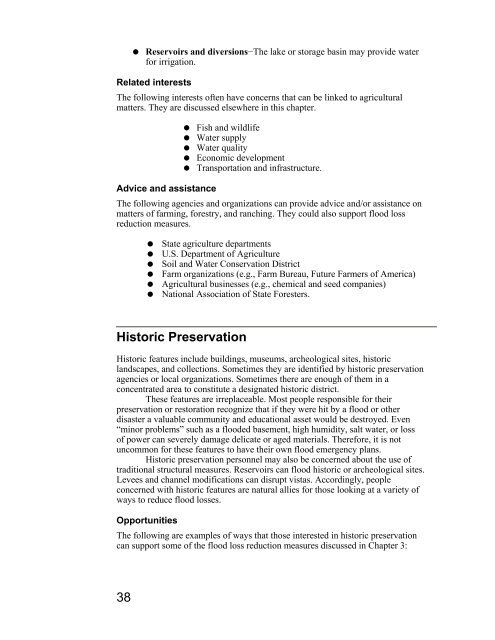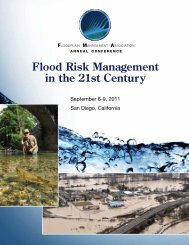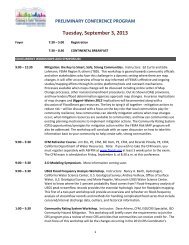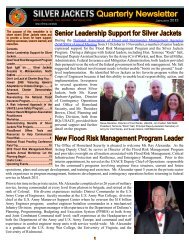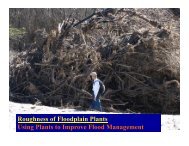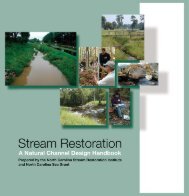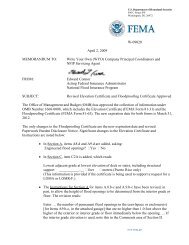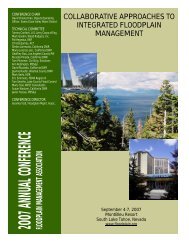Using Multi-Objective Management to Reduce Flood Losses in Your
Using Multi-Objective Management to Reduce Flood Losses in Your
Using Multi-Objective Management to Reduce Flood Losses in Your
Create successful ePaper yourself
Turn your PDF publications into a flip-book with our unique Google optimized e-Paper software.
Reservoirs and diversions−The lake or s<strong>to</strong>rage bas<strong>in</strong> may provide water<br />
for irrigation.<br />
Related <strong>in</strong>terests<br />
The follow<strong>in</strong>g <strong>in</strong>terests often have concerns that can be l<strong>in</strong>ked <strong>to</strong> agricultural<br />
matters. They are discussed elsewhere <strong>in</strong> this chapter.<br />
Fish and wildlife<br />
Water supply<br />
Water quality<br />
Economic development<br />
Transportation and <strong>in</strong>frastructure.<br />
Advice and assistance<br />
The follow<strong>in</strong>g agencies and organizations can provide advice and/or assistance on<br />
matters of farm<strong>in</strong>g, forestry, and ranch<strong>in</strong>g. They could also support flood loss<br />
reduction measures.<br />
State agriculture departments<br />
U.S. Department of Agriculture<br />
Soil and Water Conservation District<br />
Farm organizations (e.g., Farm Bureau, Future Farmers of America)<br />
Agricultural bus<strong>in</strong>esses (e.g., chemical and seed companies)<br />
National Association of State Foresters.<br />
His<strong>to</strong>ric Preservation<br />
His<strong>to</strong>ric features <strong>in</strong>clude build<strong>in</strong>gs, museums, archeological sites, his<strong>to</strong>ric<br />
landscapes, and collections. Sometimes they are identified by his<strong>to</strong>ric preservation<br />
agencies or local organizations. Sometimes there are enough of them <strong>in</strong> a<br />
concentrated area <strong>to</strong> constitute a designated his<strong>to</strong>ric district.<br />
These features are irreplaceable. Most people responsible for their<br />
preservation or res<strong>to</strong>ration recognize that if they were hit by a flood or other<br />
disaster a valuable community and educational asset would be destroyed. Even<br />
“m<strong>in</strong>or problems” such as a flooded basement, high humidity, salt water, or loss<br />
of power can severely damage delicate or aged materials. Therefore, it is not<br />
uncommon for these features <strong>to</strong> have their own flood emergency plans.<br />
His<strong>to</strong>ric preservation personnel may also be concerned about the use of<br />
traditional structural measures. Reservoirs can flood his<strong>to</strong>ric or archeological sites.<br />
Levees and channel modifications can disrupt vistas. Accord<strong>in</strong>gly, people<br />
concerned with his<strong>to</strong>ric features are natural allies for those look<strong>in</strong>g at a variety of<br />
ways <strong>to</strong> reduce flood losses.<br />
Opportunities<br />
The follow<strong>in</strong>g are examples of ways that those <strong>in</strong>terested <strong>in</strong> his<strong>to</strong>ric preservation<br />
can support some of the flood loss reduction measures discussed <strong>in</strong> Chapter 3:<br />
38


